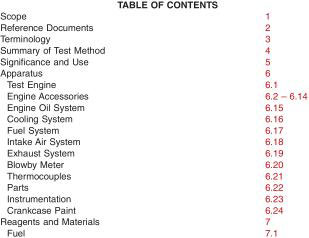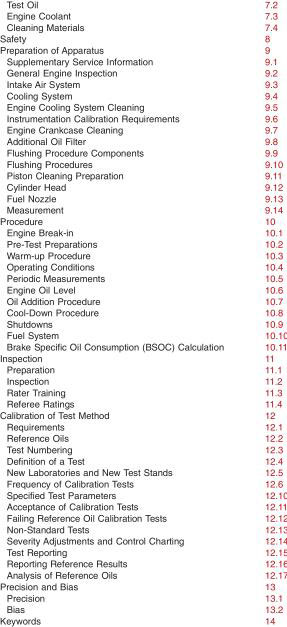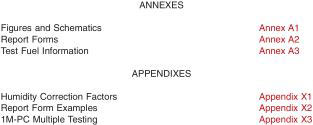1. Scope
1.1 This test method covers a four-stroke cycle diesel engine test procedure for evaluating engine oils for certain high-temperature performance characteristics, particularly ring sticking, ring and cylinder wear, and accumulation of piston deposits. Such oils include both single viscosity SAE grade and multiviscosity SAE grade oils used in diesel engines. It is commonly known as the 1M-PC test (PC for Pre-Chamber) and is used in several API oil categories, notably the CF and CF-2 and the military category described in MIL-PRF-2104 (see Note 1).
NOTE 1 - Companion test methods used to evaluate other engine oil performance characteristics for API oil categories CF and CF-2 are discussed in SAE J304. The companion tests used by the military can be found in MIL-PRF-2104.
1.2 The values stated in SI units are to be regarded as standard. The values in parentheses are provided for information only.
1.3 This standard does not purport to address all of the safety concerns, if any, associated with its use. It is the responsibility of the user of this standard to establish appropriate safety and health practices and determine the applicability of regulatory limitations prior to use.
1.4 This test method is arranged as follows:



2. Referenced Documents
2.1 ASTM Standards:
D86 Test Method for Distillation of Petroleum Products at Atmospheric Pressure
D93 Test Methods for Flash Point by Pensky-Martens Closed Cup Tester
D97 Test Method for Pour Point of Petroleum Products
D130 Test Method for Corrosiveness to Copper from Petroleum Products by Copper Strip Test
D235 Specification for Mineral Spirits (Petroleum Spirits) (Hydrocarbon Dry Cleaning Solvent)
D445 Test Method for Kinematic Viscosity of Transparent and Opaque Liquids (and Calculation of Dynamic Viscosity)
D482 Test Method for Ash from Petroleum Products
D524 Test Method for Ramsbottom Carbon Residue of Petroleum Products
D613 Test Method for Cetane Number of Diesel Fuel Oil
D664 Test Method for Acid Number of Petroleum Products by Potentiometric Titration
D1319 Test Method for Hydrocarbon Types in Liquid Petroleum Products by Fluorescent Indicator Adsorption
D1796 Test Method for Water and Sediment in Fuel Oils by the Centrifuge Method (Laboratory Procedure)
D2422 Classification of Industrial Fluid Lubricants by Viscosity System
D2425 Test Method for Hydrocarbon Types in Middle Distillates by Mass Spectrometry
D2500 Test Method for Cloud Point of Petroleum Products
D2622 Test Method for Sulfur in Petroleum Products by Wavelength Dispersive X-ray Fluorescence Spectrometry
D4052 Test Method for Density, Relative Density, and API Gravity of Liquids by Digital Density Meter
D4175 Terminology Relating to Petroleum, Petroleum Products, and Lubricants
D4294 Test Method for Sulfur in Petroleum and Petroleum Products by Energy Dispersive X-ray Fluorescence Spectrometry
D4485 Specification for Performance of Active API Service Category Engine Oils
D4863 Test Method for Determination of Lubricity of Two-Stroke-Cycle Gasoline Engine Lubricants
D5302 Test Method for Evaluation of Automotive Engine Oils for Inhibition of Deposit Formation and Wear in a Spark-Ignition Internal Combustion Engine Fueled with Gasoline and Operated Under Low-Temperature, Light-Duty Conditions (Withdrawn 2003)
D5844 Test Method for Evaluation of Automotive Engine Oils for Inhibition of Rusting (Sequence IID) (Withdrawn 2003)
D5862 Test Method for Evaluation of Engine Oils in Two-Stroke Cycle Turbo-Supercharged 6V92TA Diesel Engine (Withdrawn 2009)
D6202 Test Method for Automotive Engine Oils on the Fuel Economy of Passenger Cars and Light-Duty Trucks in the Sequence VIA Spark Ignition Engine (Withdrawn 2009)
2.2 SAE Standard:
SAE J304 Engine Oil Tests
2.3 Military Standard:
MIL-PRF-2104 Lubricating Oil, Internal Combustion Engine, Combat/Tactical Service
2.4 Other ASTM Document:
ASTM Deposit Rating Manual 20 (formerly CRC Manual 20)
3. Terminology
3.1 Definitions:
3.1.1 calibrate, v - to determine the indication or output of a measuring device with respect to that of a standard.
3.1.2 candidate oil, n - an oil that is intended to have the performance characteristics necessary to satisfy a specification and is tested against that specification.
3.1.3 clogging, n - the restriction of a flow path due to the accumulation of material along the flow path boundaries.
3.1.4 engine oil, n - a liquid that reduces friction or wear, or both, between the moving parts within an engine; removes heat, particularly from the underside of pistons; and serves as a combustion gas sealant for the piston rings.
3.1.4.1 Discussion - It may contain additives to enhance certain properties. Inhibition of engine rusting, deposit formation, valve train wear, oil oxidation, and foaming are examples.
3.1.5 non-reference oil, n - any oil other than a reference oil: such as a research formulation, commercial oil, or candidate oil.
3.1.6 purchaser, n - of an ASTM test, a person or organization that pays for the conduct of an ASTM test method on a specified product.
3.1.6.1 Discussion - The preferred term is purchaser. Deprecated terms that have been used are client, requester, sponsor, and customer.
3.1.7 reference oil, n - an oil of known performance characteristics, used as a basis for comparison.
3.1.7.1 Discussion - Reference oils are used to calibrate testing facilities, to compare the performance of other oils, or to evaluate other materials (such as seals) that interact with oils.
3.1.8 scuff, scuffing, n - in lubrication, damage caused by instantaneous localized welding between surfaces in relative motion which does not result in immobilization of the parts.
3.1.9 wear, n - the loss of material from, or relocation of material on, a surface.
3.1.9.1 Discussion - Wear generally occurs between two surfaces moving relative to each other and is the result of mechanical or chemical action or by a combination of mechanical and chemical actions.
3.2 Definitions of Terms Specific to This Standard:
3.2.1 calibration test, n - an engine test conducted on a reference oil under carefully prescribed conditions whose result is used to determine the suitability of the engine stand/laboratory to conduct such tests on non-reference oils.
3.2.1.1 Discussion - In this test method, it can also refer to tests conducted on parts to ensure their suitability for use in reference or non-reference tests.
3.2.2 test, n - any test time accumulated in accordance with this test method.



